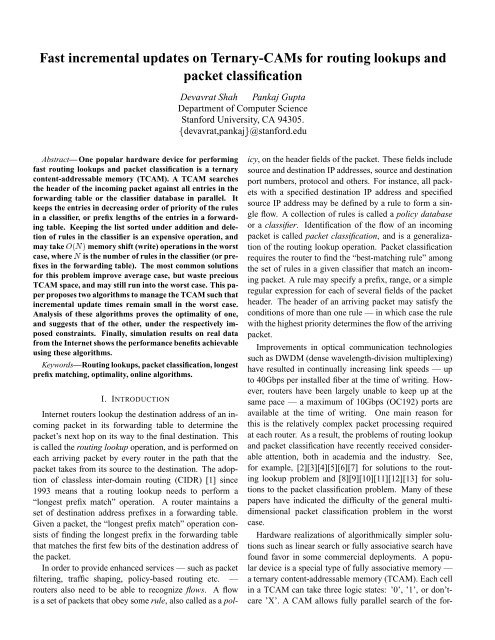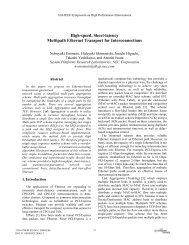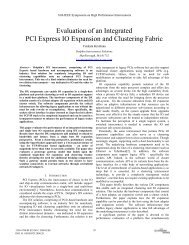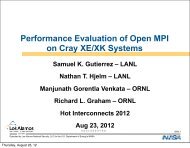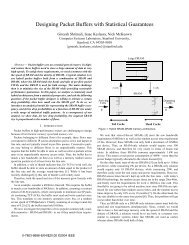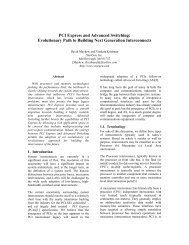Fast incremental updates on Ternary-CAMs for routing lookups and ...
Fast incremental updates on Ternary-CAMs for routing lookups and ...
Fast incremental updates on Ternary-CAMs for routing lookups and ...
Create successful ePaper yourself
Turn your PDF publications into a flip-book with our unique Google optimized e-Paper software.
<str<strong>on</strong>g>Fast</str<strong>on</strong>g> <str<strong>on</strong>g>incremental</str<strong>on</strong>g> <str<strong>on</strong>g>updates</str<strong>on</strong>g> <strong>on</strong> <strong>Ternary</strong>-<strong>CAMs</strong> <strong>for</strong> <strong>routing</strong> <strong>lookups</strong> <strong>and</strong><br />
packet classificati<strong>on</strong><br />
Devavrat Shah Pankaj Gupta<br />
Department of Computer Science<br />
Stan<strong>for</strong>d University, CA 94305.<br />
devavrat,pankaj@stan<strong>for</strong>d.edu<br />
Abstract— One popular hardware device <strong>for</strong> per<strong>for</strong>ming<br />
fast <strong>routing</strong> <strong>lookups</strong> <strong>and</strong> packet classificati<strong>on</strong> is a ternary<br />
c<strong>on</strong>tent-addressable memory (TCAM). A TCAM searches<br />
the header of the incoming packet against all entries in the<br />
<strong>for</strong>warding table or the classifier database in parallel. It<br />
keeps the entries in decreasing order of priority of the rules<br />
in a classifier, or prefix lengths of the entries in a <strong>for</strong>warding<br />
table. Keeping the list sorted under additi<strong>on</strong> <strong>and</strong> deleti<strong>on</strong><br />
of rules in the classifier is an expensive operati<strong>on</strong>, <strong>and</strong><br />
may take ǴƵ memory shift (write) operati<strong>on</strong>s in the worst<br />
case, where Æ is the number of rules in the classifier (or prefixes<br />
in the <strong>for</strong>warding table). The most comm<strong>on</strong> soluti<strong>on</strong>s<br />
<strong>for</strong> this problem improve average case, but waste precious<br />
TCAM space, <strong>and</strong> may still run into the worst case. This paper<br />
proposes two algorithms to manage the TCAM such that<br />
<str<strong>on</strong>g>incremental</str<strong>on</strong>g> update times remain small in the worst case.<br />
Analysis of these algorithms proves the optimality of <strong>on</strong>e,<br />
<strong>and</strong> suggests that of the other, under the respectively imposed<br />
c<strong>on</strong>straints. Finally, simulati<strong>on</strong> results <strong>on</strong> real data<br />
from the Internet shows the per<strong>for</strong>mance benefits achievable<br />
using these algorithms.<br />
Keywords—Routing <strong>lookups</strong>, packet classificati<strong>on</strong>, l<strong>on</strong>gest<br />
prefix matching, optimality, <strong>on</strong>line algorithms.<br />
I. INTRODUCTION<br />
Internet routers lookup the destinati<strong>on</strong> address of an incoming<br />
packet in its <strong>for</strong>warding table to determine the<br />
packet’s next hop <strong>on</strong> its way to the final destinati<strong>on</strong>. This<br />
is called the <strong>routing</strong> lookup operati<strong>on</strong>, <strong>and</strong> is per<strong>for</strong>med <strong>on</strong><br />
each arriving packet by every router in the path that the<br />
packet takes from its source to the destinati<strong>on</strong>. The adopti<strong>on</strong><br />
of classless inter-domain <strong>routing</strong> (CIDR) [1] since<br />
1993 means that a <strong>routing</strong> lookup needs to per<strong>for</strong>m a<br />
“l<strong>on</strong>gest prefix match” operati<strong>on</strong>. A router maintains a<br />
set of destinati<strong>on</strong> address prefixes in a <strong>for</strong>warding table.<br />
Given a packet, the “l<strong>on</strong>gest prefix match” operati<strong>on</strong> c<strong>on</strong>sists<br />
of finding the l<strong>on</strong>gest prefix in the <strong>for</strong>warding table<br />
that matches the first few bits of the destinati<strong>on</strong> address of<br />
the packet.<br />
In order to provide enhanced services — such as packet<br />
filtering, traffic shaping, policy-based <strong>routing</strong> etc. —<br />
routers also need to be able to recognize flows. A flow<br />
is a set of packets that obey some rule, also called as a policy,<br />
<strong>on</strong> the header fields of the packet. These fields include<br />
source <strong>and</strong> destinati<strong>on</strong> IP addresses, source <strong>and</strong> destinati<strong>on</strong><br />
port numbers, protocol <strong>and</strong> others. For instance, all packets<br />
with a specified destinati<strong>on</strong> IP address <strong>and</strong> specified<br />
source IP address may be defined by a rule to <strong>for</strong>m a single<br />
flow. A collecti<strong>on</strong> of rules is called a policy database<br />
or a classifier. Identificati<strong>on</strong> of the flow of an incoming<br />
packet is called packet classificati<strong>on</strong>, <strong>and</strong> is a generalizati<strong>on</strong><br />
of the <strong>routing</strong> lookup operati<strong>on</strong>. Packet classificati<strong>on</strong><br />
requires the router to find the “best-matching rule” am<strong>on</strong>g<br />
the set of rules in a given classifier that match an incoming<br />
packet. A rule may specify a prefix, range, or a simple<br />
regular expressi<strong>on</strong> <strong>for</strong> each of several fields of the packet<br />
header. The header of an arriving packet may satisfy the<br />
c<strong>on</strong>diti<strong>on</strong>s of more than <strong>on</strong>e rule — in which case the rule<br />
with the highest priority determines the flow of the arriving<br />
packet.<br />
Improvements in optical communicati<strong>on</strong> technologies<br />
such as DWDM (dense wavelength-divisi<strong>on</strong> multiplexing)<br />
have resulted in c<strong>on</strong>tinually increasing link speeds — up<br />
to 40Gbps per installed fiber at the time of writing. However,<br />
routers have been largely unable to keep up at the<br />
same pace — a maximum of 10Gbps (OC192) ports are<br />
available at the time of writing. One main reas<strong>on</strong> <strong>for</strong><br />
this is the relatively complex packet processing required<br />
at each router. As a result, the problems of <strong>routing</strong> lookup<br />
<strong>and</strong> packet classificati<strong>on</strong> have recently received c<strong>on</strong>siderable<br />
attenti<strong>on</strong>, both in academia <strong>and</strong> the industry. See,<br />
<strong>for</strong> example, [2][3][4][5][6][7] <strong>for</strong> soluti<strong>on</strong>s to the <strong>routing</strong><br />
lookup problem <strong>and</strong> [8][9][10][11][12][13] <strong>for</strong> soluti<strong>on</strong>s<br />
to the packet classificati<strong>on</strong> problem. Many of these<br />
papers have indicated the difficulty of the general multidimensi<strong>on</strong>al<br />
packet classificati<strong>on</strong> problem in the worst<br />
case.<br />
Hardware realizati<strong>on</strong>s of algorithmically simpler soluti<strong>on</strong>s<br />
such as linear search or fully associative search have<br />
found favor in some commercial deployments. A popular<br />
device is a special type of fully associative memory —<br />
a ternary c<strong>on</strong>tent-addressable memory (TCAM). Each cell<br />
in a TCAM can take three logic states: ’0’, ’1’, or d<strong>on</strong>’tcare<br />
’X’. A CAM allows fully parallel search of the <strong>for</strong>-
2<br />
warding table or classifier database. The ternary capability<br />
allows the TCAM to store wildcards <strong>and</strong> variable length<br />
prefixes by storing d<strong>on</strong>’t cares. Lookups are perfomed in a<br />
TCAM by storing <strong>for</strong>warding table entries in order of decreasing<br />
prefix lengths <strong>and</strong> choosing the first entry am<strong>on</strong>g<br />
all the entries that match the incoming packet’s destinati<strong>on</strong><br />
address. Packet classificati<strong>on</strong> is carried out similarly<br />
by storing classifier rules in order of decreasing priority.<br />
The need to maintain a sorted list makes <str<strong>on</strong>g>incremental</str<strong>on</strong>g> <str<strong>on</strong>g>updates</str<strong>on</strong>g><br />
slow in a TCAM. If Æ is the total number of prefixes<br />
to be stored in a TCAM having Å entries, naive additi<strong>on</strong><br />
of a new entry can result in the need to move Ç´Æ µ TCAM<br />
entries to create the space required to add the entry at a<br />
particular place in the TCAM to maintain the sorted order.<br />
Alternatively, some entries in the TCAM can be intenti<strong>on</strong>ally<br />
left lying unused in anticipati<strong>on</strong> of future additi<strong>on</strong>s<br />
— but this leads to wasted space <strong>and</strong> under-utilizati<strong>on</strong> of<br />
the TCAM memory. Besides, the worst case still remains<br />
Ç´Æ µ.<br />
This paper is motivated by the desire to simultaneously<br />
achieve fast <str<strong>on</strong>g>incremental</str<strong>on</strong>g> <str<strong>on</strong>g>updates</str<strong>on</strong>g> as well as full utilizati<strong>on</strong><br />
of the TCAM. With this objective, the paper describes<br />
worst-case algorithms (<strong>on</strong>e specific <strong>for</strong> route <strong>lookups</strong>, <strong>and</strong><br />
the other suitable <strong>for</strong> both <strong>lookups</strong> <strong>and</strong> classificati<strong>on</strong>) that<br />
achieve the optimal number of TCAM memory operati<strong>on</strong>s<br />
(such as move/write/read) required <strong>for</strong> an <str<strong>on</strong>g>incremental</str<strong>on</strong>g> update.<br />
The algorithms are <strong>on</strong>line in the sense that they per<strong>for</strong>m<br />
operati<strong>on</strong>s <strong>on</strong> memory as update requests arrive, instead<br />
of batching several update requests. In particular, the<br />
paper shows that, if Ä is the width of the destinati<strong>on</strong> address<br />
field (Ä equals ¿¾ in IPv4, <strong>and</strong> ½¾ in IPv6), no more<br />
than ľ memory operati<strong>on</strong>s are required. This algorithm<br />
is proved to be optimal; i.e., per<strong>for</strong>ms no worse than any<br />
other algorithm in the worst-case that keeps the list of <strong>for</strong>warding<br />
table entries in order of decreasing prefix lengths.<br />
This compares favorably with the Ä memory operati<strong>on</strong>s in<br />
the memory management schemes recommended by some<br />
TCAM vendors [14], <strong>and</strong> discussed later in the paper.<br />
It turns out that it is not necessary to keep all the <strong>for</strong>warding<br />
table entries in order of decreasing prefix lengths<br />
— instead, <strong>on</strong>ly overlapping prefixes need to be in this order.<br />
Two prefixes overlap if <strong>on</strong>e is a prefix of the other;<br />
<strong>for</strong> example ¼½£ overlaps with ¼½¼½£, but not with ¼¼½£.<br />
This observati<strong>on</strong> is used in the sec<strong>on</strong>d algorithm — though<br />
not proved, this algorithm seems to be optimal in the number<br />
of worst-case memory operati<strong>on</strong>s required to h<strong>and</strong>le a<br />
<strong>for</strong>warding table update. It is also menti<strong>on</strong>ed how this algorithm<br />
<strong>and</strong> results <strong>for</strong> <strong>routing</strong> <strong>lookups</strong> extend to packet<br />
classificati<strong>on</strong>.<br />
To the best of our knowledge, there is no previous work<br />
that attempts to (algorithmically) optimize <str<strong>on</strong>g>updates</str<strong>on</strong>g> <strong>on</strong> a<br />
Memory<br />
Locati<strong>on</strong> Prefix Next-hop<br />
0 P1 103.23.3/24 171.3.2.22<br />
1 P2 103.23/16 171.3.2.4<br />
103.23.3.7<br />
2 P3 101.1/16 120.33.32.98 Priority<br />
3 P4 101.20/13 320.3.3.1 Encoder P1<br />
4<br />
5<br />
6<br />
7<br />
P5 100/9 10.0.0.111<br />
171.3.2.22<br />
Figure 1. L<strong>on</strong>gest prefix matching using TCAM<br />
TCAM. Most TCAM vendors live with a Ç´Æ µ worst-case<br />
update time soluti<strong>on</strong>. Some attempt to provide a hardware<br />
“max” functi<strong>on</strong> that computes the maximum of the prefix<br />
lengths (or priorities) of all matching entries, hence<br />
eliminating the requirement of keeping the table entries<br />
sorted. However, computing maximum of Ç´Å µ ÐÓ ¾ Å-<br />
bit numbers is expensive in current technology in terms of<br />
logic area <strong>and</strong> speed. (Å is around 16K to 64K at the time<br />
of writing this paper). This is likely to get worse in the future<br />
as T<strong>CAMs</strong> scale to greater densities. Another recent<br />
paper [15] uses circuit-level optimizati<strong>on</strong>s <strong>for</strong> fast <str<strong>on</strong>g>updates</str<strong>on</strong>g><br />
at the cost of slower search time <strong>and</strong> lower memory density.<br />
It should be noted that while the algorithms in this paper<br />
have been menti<strong>on</strong>ed in the c<strong>on</strong>text of a parallel-search<br />
TCAM, they are equally applicable to other algorithms<br />
that keep a sorted list of <strong>for</strong>warding table entries or classifier<br />
rules, such as hardware realizati<strong>on</strong>s of a linear search<br />
algorithm.<br />
II. LONGEST-PREFIX MATCHING USING TCAMS<br />
IP addresses are written in the dotted quad notati<strong>on</strong>,<br />
<strong>for</strong> instance, 103.23.3.1 representing the four bytes of an<br />
IPv4 destinati<strong>on</strong> address separated by dots. An entry in a<br />
router’s <strong>for</strong>warding table is a pair route-prefix, nextHop.<br />
A route-prefix, or simply a prefix, is represented like an<br />
IP address but may have some trailing bits treated as wildcards<br />
— this denotes the aggregati<strong>on</strong> of several 32-bit destinati<strong>on</strong><br />
IP addresses. For example, the aggregati<strong>on</strong> of 256<br />
addresses 103.23.3.0 through 103.23.3.255 is represented<br />
by the prefix 103.23.3/24, where 24 is the length of the<br />
prefix, <strong>and</strong> the last 8 bits are wildcards. Other examples of<br />
prefixes are 101/8, 54.128/10, 38.23.32/21, 200.3.41.1/32<br />
etc. nextHop is the IP address of a router or end-host that<br />
is a neighbor of this router.<br />
Given an incoming packet’s destinati<strong>on</strong> address, a <strong>routing</strong><br />
lookup operati<strong>on</strong> finds the entry with the l<strong>on</strong>gest, i.e.,<br />
the most specific, of all the prefixes matching the first few<br />
bits of the incoming packet’s destinati<strong>on</strong> address; <strong>and</strong> then<br />
<strong>for</strong>wards the incoming packet to this entry’s next hop address.<br />
This l<strong>on</strong>gest prefix matching operati<strong>on</strong> is per<strong>for</strong>med<br />
in a TCAM by storing entries in decreasing order of prefix
3<br />
0<br />
32-bit prefixes<br />
0<br />
32-bit prefixes<br />
31-bit prefixes<br />
31-bit prefixes<br />
30-bit prefixes<br />
30-bit prefixes<br />
9-bit prefixes<br />
9-bit prefixes<br />
8-bit prefixes<br />
N-1<br />
M-1<br />
8-bit prefixes<br />
M-1<br />
Empty space<br />
Figure 2. General c<strong>on</strong>figurati<strong>on</strong> of a TCAM used <strong>for</strong> l<strong>on</strong>gest<br />
prefix matching. No prefixes of length less than 8-bits are<br />
shown, because they are typically not found in <strong>for</strong>warding<br />
tables<br />
Figure 3. This naive soluti<strong>on</strong> keeps the free space pool at the<br />
bottom of memory.<br />
0<br />
32-bit prefixes<br />
31-bit prefixes<br />
lengths. The TCAM searches the destinati<strong>on</strong> address of an<br />
incoming packet with all the prefixes in parallel. Several<br />
prefixes (up to L=32 in case of IPv4 <strong>lookups</strong>) may match<br />
the destinati<strong>on</strong> address. A priority encoder logic then selects<br />
the first matching entry, i.e., the entry with the matching<br />
prefix at the lowest physical memory address. An example<br />
is shown in Figure 1. The general c<strong>on</strong>figurati<strong>on</strong> <strong>for</strong><br />
storing Æ prefixes in a TCAM with Å memory locati<strong>on</strong>s,<br />
is shown in Figure 2. We will refer to the set of all prefixes<br />
of length as È . We will also assume a memory manager<br />
software that arranges prefixes in the desired order<br />
<strong>and</strong> sends appropriate instructi<strong>on</strong>s to the TCAM hardware.<br />
Forwarding tables in routers are dynamic — prefixes<br />
can be added or deleted as links go up or down due to<br />
changes in network topology. These changes can occur<br />
at the rate of approximately 100-1000 prefixes per sec<strong>on</strong>d<br />
[16]. While this is slow in comparis<strong>on</strong> to the packet<br />
lookup rate (which is of the order of milli<strong>on</strong>s of packets<br />
per sec<strong>on</strong>d), it is desirable to obtain quick TCAM <str<strong>on</strong>g>updates</str<strong>on</strong>g>.<br />
Slow <str<strong>on</strong>g>updates</str<strong>on</strong>g> may cause incoming packets to be buffered<br />
while an update operati<strong>on</strong> is being carried out, which is<br />
undesirable <strong>for</strong> many applicati<strong>on</strong>s because it may cause<br />
head-of-line blocking <strong>and</strong> requirement of a large buffer<br />
space separate from the main packet buffer memory in the<br />
router. Indeed, a single cycle update time is being used by<br />
some TCAM vendors [17] as a big competitive advantage.<br />
Hence, it is desirable to keep the <str<strong>on</strong>g>incremental</str<strong>on</strong>g> update time<br />
as small as possible.<br />
Forwarding table <str<strong>on</strong>g>updates</str<strong>on</strong>g> complicate keeping the list of<br />
prefixes in the TCAM in sorted order. This issue is best<br />
explained with the example of Figure 1. Assume that a<br />
new prefix 103.23.128/18 is to be added to the <strong>for</strong>warding<br />
table. It must be stored between prefixes 103.23.3/24 (P1)<br />
<strong>and</strong> 103.23/16 (P2), currently at memory locati<strong>on</strong>s ¼ <strong>and</strong> ½<br />
M-1<br />
30-bit prefixes<br />
9-bit prefixes<br />
8-bit prefixes<br />
Empty space<br />
Figure 4. This soluti<strong>on</strong> improves the average case update time<br />
by keeping empty spaces interspersed with prefixes in the<br />
TCAM.<br />
to maintain the sorted order. There is a problem since there<br />
is no empty space at that locati<strong>on</strong>. There can be several<br />
ways to h<strong>and</strong>le this issue:<br />
The TCAM manager keeps the free space pool (c<strong>on</strong>taining<br />
all unutilized TCAM entries) at <strong>on</strong>e end of the TCAM,<br />
say at the bottom, as shown in Figure 3. A naive soluti<strong>on</strong><br />
would shift prefixes P2 to P5 downwards in memory by<br />
<strong>on</strong>e locati<strong>on</strong> each, thus creating an empty space between<br />
P1 <strong>and</strong> P2 where the new prefix can be stored. This has<br />
worst-case time complexity Ç´Æ µ, where Æ is the number<br />
of prefixes in the TCAM of size Å, <strong>and</strong> is clearly<br />
expensive. For instance, if Æ ¼¼¼, it will take 1.2<br />
millisec<strong>on</strong>ds (assuming <strong>on</strong>e memory write operati<strong>on</strong> can<br />
be per<strong>for</strong>med in a 20ns clock cycle) to complete <strong>on</strong>e update<br />
operati<strong>on</strong> — too slow <strong>for</strong> a lookup engine which completes<br />
<strong>on</strong>e lookup in 20ns, as a large packet buffer will be<br />
required to store incoming packets while an update is being<br />
completed.<br />
In anticipati<strong>on</strong> of additi<strong>on</strong>s <strong>and</strong> deleti<strong>on</strong>s of prefixes, the<br />
TCAM may keep a few empty memory locati<strong>on</strong>s every <br />
n<strong>on</strong>-empty memory locati<strong>on</strong>s, as shown in Figure 4. The
4<br />
0<br />
32-bit prefixes<br />
31-bit prefixes<br />
30-bit prefixes<br />
Q1<br />
9-bit prefixes<br />
Q2<br />
N-1<br />
8-bit prefixes<br />
Empty space<br />
Q3<br />
Q4<br />
M-1<br />
Figure 5.<br />
The prefix-length ordering c<strong>on</strong>straint enables an<br />
empty memory locati<strong>on</strong> to be found in at most Ä ¿¾<br />
memory shifts.<br />
average case update time improves to Ç´µ but degenerates<br />
to Ç´Æ µ if the intermediate empty spaces are filled up.<br />
This soluti<strong>on</strong> also wastes precious CAM memory space.<br />
The following soluti<strong>on</strong> is based <strong>on</strong> the observati<strong>on</strong> that<br />
two prefixes that are of the same length do not need to be<br />
in any specific order. This means that if ,allprefixes<br />
in the set È must appear be<strong>for</strong>e those in the set È ,but<br />
prefixes within the set È may appear in any order. Hence,<br />
there is <strong>on</strong>ly a partial ordering c<strong>on</strong>straint between all prefixes<br />
(as opposed to a complete ordering c<strong>on</strong>straint in the<br />
naive soluti<strong>on</strong>). We call this c<strong>on</strong>straint the prefix-length<br />
ordering c<strong>on</strong>straint. This observati<strong>on</strong> leads to an algorithm,<br />
referred to here as the Ä-algorithm, that can create<br />
an empty space in a TCAM in no more than Ä memory<br />
shifts (recall that Ä ¿¾), as shown in Figure 5. The average<br />
case can be improved again by keeping some empty<br />
spaces in between, <strong>and</strong> not all at the bottom of the TCAM.<br />
Secti<strong>on</strong> III-A proposes an optimal algorithm, PLO OPT,<br />
that brings down the worst case number of memory operati<strong>on</strong>s<br />
per update to ľ.<br />
It turns out that the prefix-length ordering c<strong>on</strong>straint<br />
is also more restrictive than what is required <strong>for</strong> correct<br />
l<strong>on</strong>gest prefix matching operati<strong>on</strong> using a TCAM. In Figure<br />
1, while prefix 103.23.3/24 (P1) needs to be at a lower<br />
memory address than prefix 103.23/16 (P2) at all times, it<br />
can be anywhere in the TCAM with respect to prefixes P3,<br />
P4 <strong>and</strong> P5. This is because P1 does not overlap with prefix<br />
P3 or P4 or P5 — i.e., no incoming destinati<strong>on</strong> address<br />
can match both P1 <strong>and</strong> P3, or P1 <strong>and</strong> P4, or P1 <strong>and</strong> P5.<br />
Hence, the c<strong>on</strong>straint <strong>on</strong> ordering of prefixes in a TCAM<br />
can now be relaxed to <strong>on</strong>ly overlapping prefixes. Since<br />
two prefixes overlap if <strong>on</strong>e is fully c<strong>on</strong>tained inside the<br />
other, there is an ordering c<strong>on</strong>straint between two prefixes<br />
Ô <strong>and</strong> Ô if <strong>and</strong> <strong>on</strong>ly if <strong>on</strong>e is a prefix of the other. If all<br />
prefixes were to be visualized as being stored in a trie data<br />
Figure 6. This figure illustrates the chain-ancestor ordering<br />
c<strong>on</strong>straint. There are two maximal chains in this trie: <strong>on</strong>e<br />
comprises Q1, Q2 <strong>and</strong> Q3; <strong>and</strong> the other comprises Q1<br />
<strong>and</strong> Q4.<br />
structure, <strong>on</strong>ly prefixes that lie <strong>on</strong> the same chain (i.e., path<br />
from the root to a leaf node) of the trie need to be ordered.<br />
For example, as shown in Figure 6, prefixes Q3, Q2 <strong>and</strong><br />
Q1 must appear in order since they lie <strong>on</strong> the same chain.<br />
Prefix Q4 can be stored anywhere with respect to Q2 <strong>and</strong><br />
Q3, but must be stored at a lower memory locati<strong>on</strong> than<br />
Q1. We will refer to this c<strong>on</strong>straint as the chain-ancestor<br />
ordering c<strong>on</strong>straint. Secti<strong>on</strong> III-B proposes an algorithm,<br />
CAO OPT, that exploits this relaxed c<strong>on</strong>straint to decrease<br />
the worst case number of memory operati<strong>on</strong>s per update<br />
to ¾, where is the maximum length of any chain in<br />
the trie. As observed in this secti<strong>on</strong>, is usually small<br />
(at most 5) <strong>for</strong> even large backb<strong>on</strong>e <strong>for</strong>warding tables —<br />
hence, this algorithm achieves worst-case <str<strong>on</strong>g>updates</str<strong>on</strong>g> in a few<br />
clock cycles.<br />
III. ALGORITHMS<br />
A. Algorithm (PLO OPT) <strong>for</strong> prefix-length ordering c<strong>on</strong>straint<br />
The basic idea of algorithm PLO OPT is to keep all the<br />
unused entries in the center of the TCAM. The arrangement<br />
(shown in Figure 7) is such that the set of prefixes<br />
of length Ä Ä ½ ľ are always above the free space<br />
pool, <strong>and</strong> the set of prefixes of length ľ ½Ä¾ ¾ ½<br />
are always below the free space pool. Additi<strong>on</strong> of a new<br />
prefixwillnowhavetoswapatmostľ memory entries<br />
in order to obtain an unused memory entry. Deleti<strong>on</strong> of<br />
a prefix is exactly the reverse of additi<strong>on</strong>, <strong>and</strong> moves the<br />
newly created space back to the center of the TCAM. The<br />
algorithm keeps a trie data structure in order to do bookkeeping<br />
of the prefixes stored in the TCAM to support the<br />
update operati<strong>on</strong>s.<br />
The average case update time can be again improved to<br />
better than ľ by keeping some unused entries near each
5<br />
0<br />
32-bit prefixes<br />
31-bit prefixes<br />
0<br />
Q3<br />
17-bit prefixes<br />
Q2<br />
Empty space<br />
16-bit prefixes<br />
Q4<br />
N-1<br />
3-bit prefixes<br />
M-1<br />
2-bit prefixes<br />
1-bit prefixes<br />
M-1<br />
Q1<br />
Figure 7. This figure shows the PLO OPT algorithm that keeps<br />
all the unused TCAM entries in the center of the TCAM<br />
such that all prefixes l<strong>on</strong>ger than 16-bits are above the<br />
empty space, <strong>and</strong> all prefixes shorter than 16-bits are below<br />
the empty space at all times.<br />
Figure 8. This figure illustrates the memory assignment of prefixes<br />
of Figure 6 under the chain-ancestor ordering c<strong>on</strong>straint.<br />
Also shown is the logical inverted trie.<br />
0<br />
set È , as was d<strong>on</strong>e in Figure 4. The worst case number of<br />
memory operati<strong>on</strong>s is now at least ľ, <strong>and</strong> can become<br />
even higher. The distributi<strong>on</strong> of the number of unused<br />
entries to be kept around È depends <strong>on</strong> the distributi<strong>on</strong><br />
of <str<strong>on</strong>g>updates</str<strong>on</strong>g>, <strong>and</strong> is there<strong>for</strong>e difficult to determine apriori.<br />
Possible heuristics <strong>for</strong> placement of empty space include<br />
a uni<strong>for</strong>m distributi<strong>on</strong>, or a distributi<strong>on</strong> learned from recently<br />
observed update requests.<br />
Algorithm PLO OPT can be proved to be an optimal <strong>on</strong>line<br />
algorithm under the prefix-length ordering c<strong>on</strong>straint.<br />
In other words, no algorithm, that is unaware of future update<br />
requests, can per<strong>for</strong>m better than algorithm PLO OPT<br />
under the prefix-length ordering c<strong>on</strong>straint.<br />
B. Algorithm (CAO OPT) <strong>for</strong> chain-ancestor ordering<br />
c<strong>on</strong>straint<br />
Be<strong>for</strong>e we describe algorithm CAO OPT, we need some<br />
terminology:<br />
¯ Ä´Ôµ = the l<strong>on</strong>gest chain comprising prefix Ô<br />
¯ ÐÒ´Ä´Ôµµ = length of (i.e., number of prefixes in)<br />
Ä´Ôµ<br />
¯ ÖÓÓØÔØ´Ôµ = the path from the trie root node to node Ô<br />
¯ ancestor of Ô = any node in rootpath(p)<br />
¯ prefix-child of Ô = a child node of Ô that has a prefix<br />
¯ дԵ = highest prefix-child of Ô — i.e., am<strong>on</strong>g the<br />
children of Ô, the node which has the highest memory locati<strong>on</strong><br />
in the TCAM<br />
¯ ÀÆ´Ôµ = the chain comprising ancestors of Ô,prefixÔ<br />
itself, дԵ, ддԵµ <strong>and</strong> so <strong>on</strong> — i.e., a descendant<br />
node of Ô is in ÀÆ´Ôµif it is the highest prefix-child<br />
of its ancestor<br />
Algorithm CAO OPT also keeps the free space pool<br />
in the center of the TCAM while maintaining the chain-<br />
LC(p)<br />
M-1<br />
pi+1<br />
pi<br />
pj<br />
hcld(p)<br />
p<br />
hcld(hcld(p))<br />
Free space pool<br />
Figure 9. This figure illustrates the distributi<strong>on</strong> of chains in<br />
the TCAM under the chain-ancestor ordering c<strong>on</strong>straint.<br />
Every prefix, Ô, is at a distance less than or equal to ¾<br />
prefixes from the free space pool, where ÐÒ´Ä´Ôµµ.<br />
ancestor ordering am<strong>on</strong>g the entries in the TCAM. Hence,<br />
a logical inverted trie can be superimposed <strong>on</strong> the prefixes<br />
stored in the TCAM. For example, the prefixes in Figure 6<br />
may be stored as shown in Figure 8, with the logical inverted<br />
trie shown in dotted lines. The basic idea is to arrange<br />
the chains in such a way so as to maintain the following<br />
invariant. Assume that ÐÒ´Ä´Ôµµ <strong>for</strong> a<br />
prefix Ô. Every prefix Ô is stored in a memory locati<strong>on</strong><br />
such that there are at most ¾ prefixes between Ô <strong>and</strong><br />
a free space entry in the TCAM. Basically, the algorithm<br />
distributes the maximal trie chains around the free space<br />
pool as equally as possible (see Figure 9).<br />
B.1 Inserti<strong>on</strong><br />
Inserti<strong>on</strong> of a new prefix Õ proceeds in the following<br />
manner. First, Ä´Õµ is identified using an auxiliary data<br />
structure that is described below, <strong>and</strong> it is determined<br />
whether Õ needs to be inserted above or below the free<br />
space pool (to maintain the balance of Ä´Õµ). The two
6<br />
0<br />
0<br />
insert q here<br />
LC(q)<br />
pi+1<br />
pi<br />
pj<br />
m1<br />
m2<br />
Free space pool<br />
m1<br />
m2<br />
p<br />
Free space pool<br />
q<br />
Delete q<br />
M-1<br />
M-1<br />
Figure 10. Showing how inserti<strong>on</strong> proceeds in Algorithm<br />
CAO OPT when the prefix to be inserted is above the free<br />
space pool<br />
LC(q)<br />
HCN(q)<br />
0<br />
insert q here<br />
m1<br />
m2<br />
M-1<br />
Free space pool<br />
Figure 11. Showing how inserti<strong>on</strong> proceeds in Algorithm<br />
CAO OPT when the prefix to be inserted is below the free<br />
space pool<br />
cases are h<strong>and</strong>led separately:<br />
Case I (Figure 10): Assume that Õ is to be inserted above<br />
the free space pool between prefixes Ô <strong>and</strong> Ô·½ <strong>on</strong> Ä´Õµ.<br />
One empty unused entry can be created at that locati<strong>on</strong> by<br />
moving prefixes <strong>on</strong> Ä´Õµ downwards <strong>on</strong>e by <strong>on</strong>e starting<br />
from Ô to the unused entry at either the top (memory<br />
locati<strong>on</strong> marked ѽ in Figure 10) or the bottom (Ѿ)<br />
of the free space pool. The total number of movements<br />
is clearly less than ¾, where ÐÒ´Ä´Õµµ. The<br />
movements do not violate the chain-ancestor ordering c<strong>on</strong>straint<br />
since a prefix is moved downwards after its ancestor<br />
has moved, <strong>and</strong> hence, the c<strong>on</strong>straint is always satisfied.<br />
Case II (Figure 11): Now assume that Õ is to be inserted<br />
below the free space pool. Creating an empty entry in the<br />
TCAM now requires moving the prefixes upwards towards<br />
the free space pool. Hence, the chain we c<strong>on</strong>sider in this<br />
case is ÀÆ´Õµ, which may or may not be identical to<br />
Ä´Õµ. Movement of prefixes <strong>on</strong>e by <strong>on</strong>e upwards does<br />
not violate the chain-ancestor ordering c<strong>on</strong>straint since a<br />
prefix is moved to the locati<strong>on</strong> previously occupied by the<br />
Figure 12. Deleti<strong>on</strong> of a prefix in Algorithm CAO OPT<br />
child that occupied the highest memory locati<strong>on</strong> am<strong>on</strong>g<br />
all the children. Again, the total number of movements is<br />
clearly less than ¾.<br />
B.2 Deleti<strong>on</strong><br />
Deleti<strong>on</strong> is similar to inserti<strong>on</strong>, except: (1) It works in<br />
reverse, moving the newly created empty space to the free<br />
space pool, <strong>and</strong> (2) It works <strong>on</strong> the chain that has the prefix<br />
Ô adjacent to the free space pool — i.e., prefix Ô is at<br />
memory locati<strong>on</strong>s ѽ ½ or Ѿ ·½. Thisisshownin<br />
Figure 12. The new unused entry created by deleti<strong>on</strong> of<br />
prefix Õ is rippled up by moving prefixes downwards <strong>on</strong><br />
this chain. The total number of movements is less than<br />
¾, where is now either the length of Ä´Ôµ if Õ<br />
is deleted from below the free space pool, or the length of<br />
ÀÆ´Ôµ if Õ is deleted from above the free space pool.<br />
B.3 Auxiliary trie data structure<br />
Algorithm CAO OPT maintains an auxiliary trie data<br />
structure similar to PLO OPT <strong>for</strong> supporting the update<br />
operati<strong>on</strong>s. However, more in<strong>for</strong>mati<strong>on</strong> is needed to be<br />
kept in a trie node,Ô, to determine Ä´Ôµ <strong>and</strong> ÀÆ´Ôµ<br />
quickly. This takes no more than Ǵĵ time by maintaining<br />
the following additi<strong>on</strong>al fields in every trie node:<br />
ÛØ´Ôµ, ÛØ ÔØÖ´Ôµ <strong>and</strong> Ð ÔØÖ´Ôµ. ÛØ´Ôµ equals:<br />
<br />
½<br />
ÑÜ´ÛØ´ÐдԵ ÖдԵµ<br />
if p is a leaf<br />
otherwise<br />
where ÐдԵ <strong>and</strong> ÖдԵ are the immediate left <strong>and</strong><br />
right children nodes of Ô respectively. ÛØ ÔØÖ´Ôµ keeps a<br />
pointer to the prefix-child which has the highest weight,<br />
<strong>and</strong> Ð ÔØÖ´Ôµ keeps a pointer to the prefix-child which<br />
appears at the highest memory locati<strong>on</strong> in the TCAM.<br />
Though we have not been able to prove, we c<strong>on</strong>jecture<br />
that algorithm CAO OPT is an optimal <strong>on</strong>line algorithm<br />
under the chain-ancestor ordering c<strong>on</strong>straint.<br />
(1)
7<br />
MAE-EAST MAE-WEST<br />
Prefixes 43344 35217<br />
Inserts 34204 34114<br />
Deletes 9140 1103<br />
TABLE I<br />
STATISTICS OF ROUTING TABLES AND UPDATE TRACES<br />
USED IN THE SIMULATIONS.<br />
Number of memory movements<br />
4.6<br />
4.4<br />
4.2<br />
4<br />
3.8<br />
3.6<br />
3.4<br />
3.2<br />
MAE-WEST<br />
MAE-EAST<br />
3<br />
11<br />
10<br />
9<br />
MAE-WEST<br />
MAE-EAST<br />
2.8<br />
2.6<br />
0 50 100 150 200 250 300 350 400 450<br />
Number of <str<strong>on</strong>g>updates</str<strong>on</strong>g> (x100)<br />
Number of memory movements<br />
8<br />
7<br />
6<br />
5<br />
4<br />
3<br />
Figure 14. The running average of the number of memory movements<br />
required by algorithm PLO OPT to support <str<strong>on</strong>g>updates</str<strong>on</strong>g><br />
<strong>on</strong> MAE-WEST <strong>and</strong> MAE-EAST <strong>routing</strong> tables.<br />
2<br />
1<br />
0<br />
0 50 100 150 200 250 300 350 400 450<br />
Number of <str<strong>on</strong>g>updates</str<strong>on</strong>g> (x100)<br />
100000<br />
MAE-WEST<br />
MAE-EAST<br />
10000<br />
Figure 13. The running average of the number of memory movements<br />
required by the Ä-algorithm to support <str<strong>on</strong>g>updates</str<strong>on</strong>g> <strong>on</strong><br />
MAE-WEST <strong>and</strong> MAE-EAST <strong>routing</strong> tables.<br />
Number of chains<br />
1000<br />
100<br />
IV. SIMULATION RESULTS<br />
This secti<strong>on</strong> presents simulati<strong>on</strong> results using two publicly<br />
available <strong>routing</strong> table snapshots (at MAE-EAST <strong>and</strong><br />
MAE-WEST network access points) <strong>and</strong> three hour BGPupdate<br />
traces <strong>on</strong> these snapshots taken from [18]. Statistics<br />
of the <strong>routing</strong> tables <strong>and</strong> BGP <str<strong>on</strong>g>updates</str<strong>on</strong>g> are shown in Table I.<br />
Figure 13 shows a running average of the number of<br />
memory movements (i.e., memory writes or shifts) required<br />
in the Ä-algorithm as a functi<strong>on</strong> of the number of<br />
<str<strong>on</strong>g>updates</str<strong>on</strong>g>. The figure shows that the average settles down to<br />
around 8 memory movements per update operati<strong>on</strong>. This<br />
is expected since most of the <str<strong>on</strong>g>updates</str<strong>on</strong>g> happen to prefixes<br />
that are between 8 <strong>and</strong> 24 bits l<strong>on</strong>g, because there are very<br />
few prefixes (less than 0.1%) that are l<strong>on</strong>ger than 24 bits.<br />
Hence, if we assume that <str<strong>on</strong>g>updates</str<strong>on</strong>g> are uni<strong>for</strong>mly distributed<br />
between these lengths, the running average should settle<br />
at ´¾ µ¾ . As shown in Figure 14, the average<br />
drops to approximately <strong>for</strong> algorithm PLO OPT. This is<br />
again expected since theoretical analysis showed an improvement<br />
over the Ä-algorithm by a factor of 2.<br />
The motivati<strong>on</strong> <strong>for</strong> a less stringent c<strong>on</strong>straint (the chainancestor<br />
ordering c<strong>on</strong>straint) is immediate from Figure 15,<br />
which plots the maximal chain length distributi<strong>on</strong> of the<br />
two <strong>routing</strong> tables. The figure shows exp<strong>on</strong>entially decreasing<br />
distributi<strong>on</strong>s — <strong>for</strong> example, 97% of the MAE-<br />
10<br />
1<br />
1 1.5 2 2.5 3 3.5 4 4.5 5<br />
Maximal chain length<br />
Figure 15. The chain length distributi<strong>on</strong> <strong>on</strong> the two <strong>routing</strong><br />
tables. Note the logarithmic scale <strong>on</strong> the y-axis<br />
Number of memory movements<br />
1.18<br />
1.16<br />
1.14<br />
1.12<br />
1.1<br />
1.08<br />
1.06<br />
1.04<br />
1.02<br />
MAE-WEST<br />
MAE-EAST<br />
1<br />
0 50 100 150 200 250 300 350 400 450<br />
Number of <str<strong>on</strong>g>updates</str<strong>on</strong>g> (x100)<br />
Figure 16. The running average of the number of memory movements<br />
required by algorithm CAO OPT to support <str<strong>on</strong>g>updates</str<strong>on</strong>g><br />
<strong>on</strong> MAE-WEST <strong>and</strong> MAE-EAST <strong>routing</strong> tables.
8<br />
Max Avg Std Dev<br />
L-algorithm 22.0 7.76 3.93<br />
PLO OPT 13.0 3.56 1.93<br />
CAO OPT 3.0 1.05 0.02<br />
TABLE II<br />
SUMMARY OF PERFORMANCE NUMBERS ON MAE-WEST<br />
ROUTING TABLE.<br />
Max Avg Std Dev<br />
L-algorithm 21.0 7.27 4.09<br />
PLO OPT 12.0 4.1 2.03<br />
CAO OPT 3.0 1.02 0.01<br />
TABLE III<br />
SUMMARY OF PERFORMANCE NUMBERS ON MAE-EAST<br />
ROUTING TABLE.<br />
EAST chains have length less than or equal to two <strong>and</strong><br />
all chains have length less than six. Figure 16 plots the<br />
running average of the number of memory movements required<br />
as a functi<strong>on</strong> of the number of <str<strong>on</strong>g>updates</str<strong>on</strong>g> using algorithm<br />
CAO OPT. This figure shows that the average drops<br />
quickly down to 1.02-1.06 <strong>for</strong> both <strong>routing</strong> tables.<br />
Per<strong>for</strong>mance summary statistics of both algorithms <strong>on</strong><br />
the two <strong>routing</strong> tables is shown in Table II <strong>and</strong> Table III.<br />
It is to be noted that the st<strong>and</strong>ard deviati<strong>on</strong> of algorithm<br />
CAO OPT is quite small (<strong>and</strong> much less than that of algorithm<br />
PLO OPT) — probably because of the exp<strong>on</strong>entially<br />
decreasing chain length distributi<strong>on</strong>. This should make algorithm<br />
CAO OPT even more attractive in practice.<br />
V. PACKET CLASSIFICATION<br />
So far we have discussed <str<strong>on</strong>g>updates</str<strong>on</strong>g> in the c<strong>on</strong>text of <strong>routing</strong><br />
<strong>lookups</strong>. Both algorithms PLO OPT <strong>and</strong> CAO OPT<br />
extend to packet classificati<strong>on</strong> as follows.<br />
The prefix-length ordering c<strong>on</strong>straint is equivalent to<br />
keeping the list of rules in a classifier ordered by priority.<br />
Algorithm PLO OPT then degenerates to the naive algorithm<br />
that requires Ç´Æ µ memory movements per update<br />
in the worst case. This could be brought down by doing<br />
an analysis to determine the set of overlapping rules <strong>and</strong><br />
generating a c<strong>on</strong>straint tree. Two rules overlap if there exists<br />
a packet which matches both rules. Only overlapping<br />
rules need to be kept in the order of their priority in the<br />
TCAM. The c<strong>on</strong>straint tree captures these c<strong>on</strong>straints in a<br />
tree <strong>for</strong>m. Now, algorithm CAO OPT can be used with little<br />
modificati<strong>on</strong>, using the c<strong>on</strong>straint tree to determine rule<br />
ordering instead of the prefix trie. Of course, the benefit of<br />
using the chain-ancestor ordering c<strong>on</strong>straint is dependent<br />
<strong>on</strong> the chain length distributi<strong>on</strong> in the c<strong>on</strong>straint tree, <strong>and</strong><br />
can <strong>on</strong>ly be determined by doing an analysis of real-life<br />
classifiers — a task made difficult by the absence of large<br />
publicly available classifiers.<br />
VI. CONCLUSIONS<br />
H<strong>and</strong>ling <str<strong>on</strong>g>incremental</str<strong>on</strong>g> <str<strong>on</strong>g>updates</str<strong>on</strong>g> in <strong>routing</strong> <strong>lookups</strong> can be<br />
slow — even in simple data structures such as that maintained<br />
in a ternary CAM. This paper proposes algorithms<br />
<strong>for</strong> high speed <str<strong>on</strong>g>updates</str<strong>on</strong>g> in T<strong>CAMs</strong> under two separate c<strong>on</strong>straints.<br />
Both algorithms do not require any additi<strong>on</strong>al circuitry<br />
<strong>on</strong> the TCAM chip <strong>and</strong> <strong>on</strong>e can be proved optimal.<br />
In particular, the paper proposes algorithm PLO OPT <strong>for</strong><br />
the stricter (<strong>and</strong> more well-known) prefix-length ordering<br />
c<strong>on</strong>straint, <strong>and</strong> achieves a factor of two update speed improvement<br />
over the best known soluti<strong>on</strong>. This paper also<br />
proposes algorithm CAO OPT <strong>for</strong> the less stringent chainancestor<br />
ordering c<strong>on</strong>straint. Algorithm CAO OPT guarantees<br />
correctness at all times, <strong>and</strong> completes <strong>on</strong>e prefix<br />
update in slightly greater than <strong>on</strong>e (observed 1.02-1.06<br />
using simulati<strong>on</strong>s <strong>on</strong> real-life <strong>routing</strong> tables <strong>and</strong> update<br />
traces) memory movements per update operati<strong>on</strong>. Algorithm<br />
CAO OPT is also useful <strong>for</strong> fast <str<strong>on</strong>g>updates</str<strong>on</strong>g> when a<br />
TCAM is used <strong>for</strong> packet classificati<strong>on</strong>.<br />
VII. ACKNOWLEDGMENTS<br />
We would like to gratefully acknowledge Spencer<br />
Greene, now at Juniper Networks, <strong>for</strong> menti<strong>on</strong>ing the possibility<br />
of a better algorithm with a less stringent c<strong>on</strong>straint<br />
than the prefix-length ordering c<strong>on</strong>straint.<br />
REFERENCES<br />
[1] Y. Rekhter <strong>and</strong> T. Li, “An Architecture <strong>for</strong> IP Address Allocati<strong>on</strong><br />
with CIDR,” RFC 1518, 1993.<br />
[2] M. Waldvogel, G. Varghese, J. Turner, <strong>and</strong> B. Plattner, “Scalable<br />
high-speed ip <strong>routing</strong> <strong>lookups</strong>,” in Proceedings of ACM SIG-<br />
COMM, Oct. 1997, pp. 25–36.<br />
[3] A. Brodnik, S. Carlss<strong>on</strong>, M. Degermark, <strong>and</strong> S. Pink, “Small<br />
<strong>for</strong>warding tables <strong>for</strong> fast <strong>routing</strong> <strong>lookups</strong>,” in Proceedings of<br />
ACM SIGCOMM, Oct. 1997, pp. 3–13.<br />
[4] P. Gupta, S. Lin, <strong>and</strong> N. McKeown, “Routing <strong>lookups</strong> in hardware<br />
at memory access speeds,” in Proceedings of INFOCOM, Mar.<br />
1998, pp. 1240–7.<br />
[5] B. Lamps<strong>on</strong>, V. Srinivasan, <strong>and</strong> G. Varghese, “IP <strong>lookups</strong> using<br />
multiway <strong>and</strong> multicolumn search,” in Proceedings of INFO-<br />
COM, Mar. 1998, pp. 1248–1256.<br />
[6] S. Nilss<strong>on</strong> <strong>and</strong> G. Karlss<strong>on</strong>, “IP-address lookup using LC-tries,”<br />
IEEE Journal <strong>on</strong> Selected Areas in Communicati<strong>on</strong>s, vol. 17, no.<br />
6, pp. 1083–92, 1999.<br />
[7] V. Srinivasan <strong>and</strong> G. Varghese, “<str<strong>on</strong>g>Fast</str<strong>on</strong>g> address <strong>lookups</strong> using c<strong>on</strong>trolled<br />
prefix expansi<strong>on</strong>,” ACM Transacti<strong>on</strong>s <strong>on</strong> Computer Systems,<br />
vol. 17, no. 1, pp. 1–40, Oct. 1999.<br />
[8] T. V. Lakshman <strong>and</strong> D. Stiliadis, “High-speed policy-based<br />
packet <strong>for</strong>warding using efficient multi-dimensi<strong>on</strong>al range match-
ing,” in Proceedings of ACM SIGCOMM, Sept. 1998, pp. 191–<br />
202.<br />
[9] V. Srinivasan, G. Varghese, S. Suri, <strong>and</strong> M. Waldvogel, “Scalable<br />
level 4 switching <strong>and</strong> fast firewall processing,” in Proceedings of<br />
ACM SIGCOMM, Sept. 1998, pp. 203–214.<br />
[10] P. Gupta <strong>and</strong> N. McKeown, “Classifying packets using hierarchical<br />
intelligent cuttings,” IEEE Micro, vol. 20, no. 1, pp. 34–41,<br />
Jan-Feb 2000.<br />
[11] P. Gupta <strong>and</strong> N. McKeown, “Packet classificati<strong>on</strong> <strong>on</strong> multiple<br />
fields,” in Proceedings of ACM SIGCOMM, Sept. 1999, pp. 147–<br />
60.<br />
[12] M. M. Buddhikot, S. Suri, <strong>and</strong> M. Waldvogel, “Space decompositi<strong>on</strong><br />
techniques <strong>for</strong> fast layer-4 switching,” Protocols <strong>for</strong> High<br />
Speed Networks, vol. 66, no. 6, pp. 277–83, Aug. 1999.<br />
[13] V. Srinivasan, G. Varghese, <strong>and</strong> S. Suri, “<str<strong>on</strong>g>Fast</str<strong>on</strong>g> packet classificati<strong>on</strong><br />
using tuple space search,” in Proceedings of ACM SIGCOMM,<br />
Sept. 1999, pp. 135–46.<br />
[14] “Sibercore technologies,” www.sibercore.com/scan01 cidr p03.pdf.<br />
[15] M. Kobayashi, T. Murase, <strong>and</strong> A. Kuriyama, “A l<strong>on</strong>gest prefix<br />
match search engine <strong>for</strong> multi-gigabit ip processing,” in Proceedings<br />
of ICC 2000, June 2000.<br />
[16] C. Labovitz, G. R. Malan, <strong>and</strong> F. Jahanian, “Internet <strong>routing</strong> instability,”<br />
The IEEE/ACM Transacti<strong>on</strong>s <strong>on</strong> Networking, vol.6,<br />
no. 5, pp. 515–28, Oct. 1999.<br />
[17] “Netlogic microsystems,” www.netlogicmicro.com.<br />
[18] “Merit,” www.merit.edu/ipma/<strong>routing</strong> table.<br />
9


